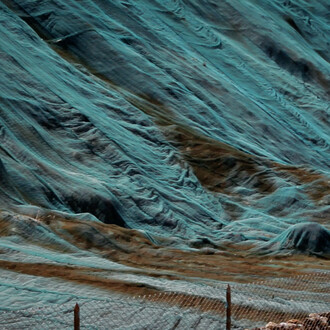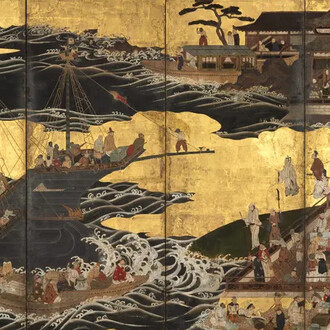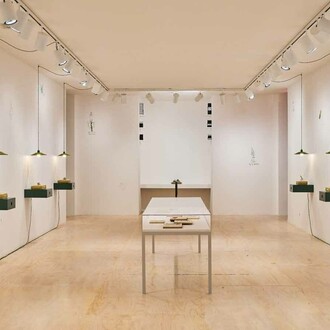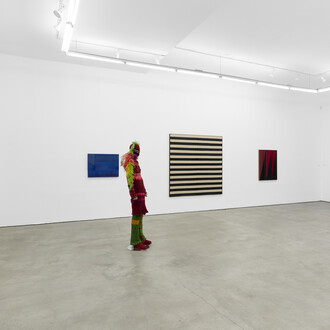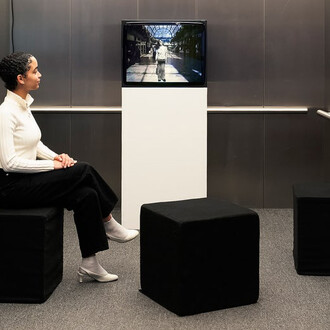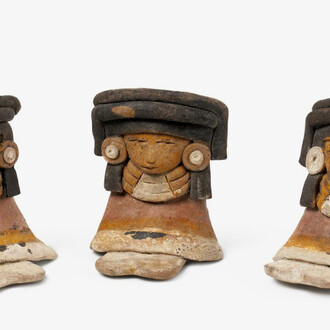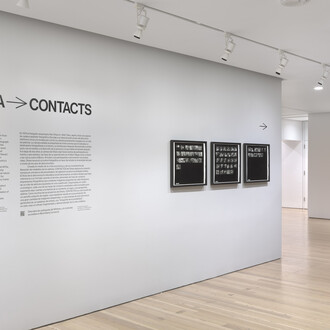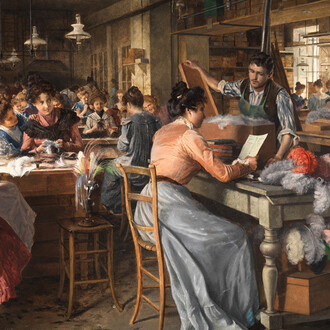The first 2014 exhibition at Nancy Hoffman Gallery is “Northwest Passage,” new oil paintings by Michael Gregory, opening on January 30th and continuing through March 8th.
For the past decade Gregory has focused on the American iconic landscape, including a barn or farm community, a silo, telephone poles, fences, fields of hay, cloud or star-filled skies. His point of departure is love of the land, particularly the West that John Steinbeck described in his books. The artist does not seek a “photoreal” representation of the land and sky; each painting in oil on canvas is a “reimagined” vision of what he has seen as he drives through vast stretches of the Western land and skyscape. Most of the paintings measure 6x5 feet, most embrace color in a poetic, subtle and rich fashion. Most of the works depict mountains against a dawn, day or nighttime sky, and through most of the works fog floats as a leitmotif. Nestled in front of the mountains are the iconic structures of the West, an old barn or a community of farm buildings inviting, yet private.
While the manifest content of the works is “the landscape,” these are not simple landscapes and not simply the landscape qua landscape. This is terrain ripe for exploration, a terrain where space seems infinite, where light can shine in the sky uninterrupted by the detritus of civilization. These are paintings harking back to another time, yet achingly contemporary. Pared to the essence of structure in the landscape, a barn sets the stage for mood, time and place, and arrests one’s eye as one views the fields and mountains and skies. The poetry in the paintings is palpable; the sense of memory is undeniable. More than his prior works, the evocation of memory is enhanced by the colors of the paintings, new, fresh, filled with the weather of rugged Western skies. These are American paintings filled with Lewis and Clark’s commitment to the future, and to the preservation of a landscape unique in the world.
Gregory has written about the new works:
“In May of 1804, Meriwether Lewis and William Clark departed from Saint Louis, Missouri to map the newly acquired Louisiana Purchase and search for what was then a centuries’ old quest for a passage across the interior to the Pacific Ocean. Their journey was a nation’s commitment to the future.
“This urge for exploration and discovery is hardwired in our genes—there from our earliest trek out of Africa to our voyage into space. It is an impulse that recurs with each generation.
“For over a decade now, I’ve been making road trips across the country with a recent focus on the West. The paintings in this show were mostly generated by the experience of driving hundreds of miles from the eastern Rockies to the Pacific Northwest, from central Idaho to Wyoming and Montana, passing the Grand Tetons, Yellowstone National Park, and the Gallatin Valley. “Northwest Passage” is a record of these journeys.
“While passing though this area, one can’t help but be awed by the extraordinary courage and fortitude of those who came before. The remains of their structures litter the vast and dwarfing landscape. What continues to amaze me in a formal way is the contrast of man-made structures to the natural environment and how they fit seamlessly into their setting, ghostly sentinels to man’s hubris.
“These paintings are not specific to actual place; they are composite reminders of where we’ve been. The meditative quality of driving long distances is recreated in the studio, with its attendant solitude and silence. Our response to landscape is visceral. Every sunrise is miraculous and novel.”
One cannot help but feel what Gregory has stated when looking at these glowing works, that indeed, “every sunrise is miraculous and novel.”
The artist’s work has been shown at The Arkansas Arts Center, Little Rock; Arvada Center for the Arts and Humanities, Denver; Boise Art Museum, Idaho, Boulder Center for the Visual Arts, Colorado; The Butler Institute of American Art, Youngstown, Ohio; California College of Arts and Crafts, Oakland; Center for the Arts, Vero Beach, Florida; Evansville Museum of Arts, Science and History, Indiana; Fine Arts Center Galleries, University of Rhode Island, Kingston; The Fine Arts Museums of San Francisco, California; Flint Institute of Arts, Michigan; Florida International University, Miami; Fort Collins Museum of Contemporary Art, Colorado; Hunter Museum of Art, Chattanooga, Tennessee; Maier Museum of Art, Randolph-Macon Woman’s College, Lynchburg, Virginia; Richmond Art Center, California; San Francisco Arts Commission Gallery, California; San Jose Institute of Contemporary Art, California; San Mateo Arts Council, California; Selby Gallery, Ringling School of Art and Design, Sarasota, Florida; The Charlotte and Philip Hanes Art Gallery, Wake Forest University, Winston-Salem, North Carolina.
His work is included in the collections of the Boise Art Museum, Idaho; Delaware Art Museum, Wilmington; Denver Art Museum, Colorado; Evansville Museum of Arts and Science and History, Indiana; San Jose Museum of Art, California, and numerous private collections.
He was Martha and Merritt deJong Memorial Artist-in-Residence, Evansville Museum of Arts, Science and History, Indiana in 2003.
Michael Gregory was born in Los Angeles in 1955. He received a Bachelor of Fine Arts from the San Francisco Art Institute. He resides in Bolinas, California with his wife and daughters.
Nancy Hoffman Gallery
520 West 27th Street
New York (NY) 10001 United States
Tel. +1 (212) 9666676
info@nancyhoffmangallery.com
www.nancyhoffmangallery.com
Opening hours
Tuesday - Saturday
From 10am to 6pm
Related images
- Michael Gregory, Gallatin, 2013, oil on canvas on panel, 73 1/2 x 63 1/2 inches
- Michael Gregory, Vanishing Point Ranch, 2013, oil on canvas on panel, 74 x62 inches
- Michael Gregory, Medicine Bow Breaks, 2013, oil on canvas on panel, 73 1/2 x 63 1/2 inches
- Michael Gregory, Alturas, 2012, oil on canvas, 72 x 60 inches
- Michael Gregory, Emmigrant Flat, 2013, oil on canvas on panel, 74 x 62 inches
- Michael Gregory, Bonner's Ridge, 2013, oil on canvas on panel, 73 3/4 x 63 1/2 inches







